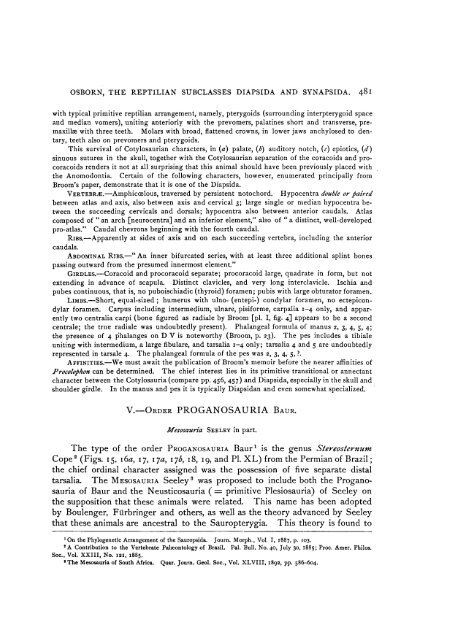American Museum of Natural History
American Museum of Natural History
American Museum of Natural History
You also want an ePaper? Increase the reach of your titles
YUMPU automatically turns print PDFs into web optimized ePapers that Google loves.
OSBORN, THE REPTILIAN SUBCLASSES DIAPSIDA AND SYNAPSIDA. 48I<br />
with typical primitive reptilian arrangement, namely, pterygoids (surrounding interpterygoid space<br />
and median vomers), uniting anteriorly with the prevomers, palatines short and transverse, premaxille<br />
with three teeth. Molars with broad, flattened crowns, in lower jaws anchylosed to dentary,<br />
teeth also on prevomers and pterygoids.<br />
This survival <strong>of</strong> Cotylosaurian characters, in (a) palate, (b) auditory notch, (c) epiotics, (d)<br />
sinuous sutures in the skull, together with the Cotylosaurian separation <strong>of</strong> the coracoids and procoracoids<br />
renders it not at all surprising that this animal should have been previously placed with<br />
the Anomodontia. Certain <strong>of</strong> the following characters, however, enumerated principally from<br />
Broom's paper, demonstrate that it is one <strong>of</strong> the Diapsida.<br />
VERTEBR&.-Amphiccelous, traversed by persistent notochord. Hypocentra double or paired<br />
between atlas and axis, also between axis and cervical 3; large single or median hypocentra between<br />
the succeeding cervicals and dorsals; hypocentra also between anterior caudals. Atlas<br />
composed <strong>of</strong> " an arch [neurocentra] and an inferior element," also <strong>of</strong> " a distinct, well-developed<br />
pro-atlas." Caudal chevrons beginning with the fourth caudal.<br />
RIBs.-Apparently at sides <strong>of</strong> axis and on each succeeding vertebra, including the anterior<br />
caudals.<br />
ABDOMINAL RIBS.-" An inner bifurcated series, with at least three additional splint bones<br />
passing outward from the presumed innermost element."<br />
GIRDLEs.-Coracoid and procoracoid separate; procoracoid large, quadrate in form, but not<br />
extending in advance <strong>of</strong> scapula. Distinct clavicles, and very long interclavicle. Ischia and<br />
pubes continuous, that is, no puboischiadic (thyroid) foramen; pubis with large obturator foramen.<br />
LIMBS.-Short, equal-sized; humerus with ulno- (entepi-) condylar foramen, no ectepicondylar<br />
foramen. Carpus including intermedium, ulnare, pisiforme, carpalia 1-4 only, and apparently<br />
two centralia carpi (bone figured as radiale by Broom [pl. I, fig. 4] appears to be a second<br />
centrale; the true radiale was undoubtedly present). Phalangeal formula <strong>of</strong> manus 2, 3, 4, 5, 4;<br />
the presence <strong>of</strong> 4 phalanges on D V is noteworthy (Broom, p. 23). The pes includes a tibiale<br />
uniting with intermedium, a large fibulare, and tarsalia 1-4 only; tarsalia 4 and 5 are undoubtedly<br />
represented in tarsale 4. The phalangeal formula <strong>of</strong> the pes was 2, 3, 4, 5,?.<br />
AFFINITIES.-We must await the publication <strong>of</strong> Broom's memoir before the nearer affinities <strong>of</strong><br />
Procolophon can be determined. The chief interest lies in its primitive transitional or annectant<br />
character between the Cotylosauria (compare pp. 456, 457) and Diapsida, especially in the skull and<br />
shoulder girdle. In the manus and pes it is typically Diapsidan and even somewhat specialized.<br />
V.-ORDER PROGANOSAURIA BAUR.<br />
Mesosauria SEELEY in part.<br />
The type <strong>of</strong> the order PROGANOSAURIA Baur' is the genus Stereoslernum<br />
Cope2 (Figs. I5, i6a, I7, I7a, 17b, i8, i9, and PI. XL) from the Permian <strong>of</strong> Brazil;<br />
the chief ordinal character assigned was the possession <strong>of</strong> five separate distal<br />
tarsalia. The MESOSAURIA Seeley3 was proposed to include both the Proganosauria<br />
<strong>of</strong> Baur and the Neusticosauria (= primitive Plesiosauria) <strong>of</strong> Seeley on<br />
the supposition that these animals were related. This name has been adopted<br />
by Boulenger, Furbringer and others, as well as the theory advanced by Seeley<br />
that these animals are ancestral to the Sauropterygia. This theory is found to<br />
' On the Pbylogenetic Arrangement <strong>of</strong> the Sauropsida. Journ. Morph., Vol I, I887, p. 103.<br />
'A Contribution to the Vertebrate Palaeontology <strong>of</strong> Brazil. Pal. Bull. No. 40, July 30, I885; Proc. Amer. Philos.<br />
Soc., Vol. XXIII, No. 121, 1885.<br />
' The Mesosauria <strong>of</strong> South Africa. Quar. Journ. Geol. Soc., Vol. XLVIII, I892, pp. 586-604.

















